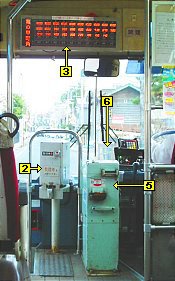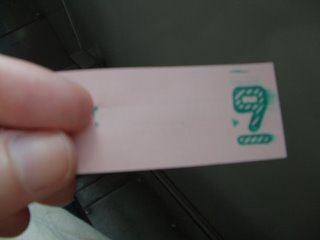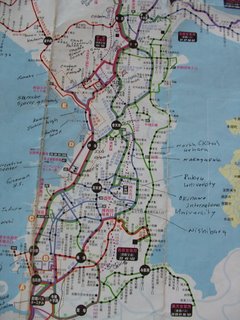
First things first, you must find a stop. Look for curved little yellow signs with bus routes posted on them. You'll need to know what number you want to catch and make sure you can read military time! It's also helpful to note that there are different route times for Saturdays and Sundays. When you see your bus approach, you must signal that you want it to stop. Buses are pretty infrequent so make sure you get on it when you see it! Next to my apartment, I have a bus that leaves at 10:27 and 1:02 on weekends. They are the two most convenient times and I have committed them to memory. Very helpful. Also, I don't really notice being stared at in Okinawa except when I'm waiting for a bus. I guess it's a pretty rare sight to see a Westerner standing either alone or with a bunch of locals waiting for a bus. Most military types are zipping around in cars with special license plates.
As you get on the bus, you must grab a little slip of paper with a number on it. (#2 on helpful diagram)...

And then just sit and enjoy the ride. I try to listen to the stops to become more familiar with the Japanese names. As your stop approaches, start digging in your change to get the fare. You are going to pay the amount that is under your number on the board in front. It goes up gradually (see #3). Easy. Except you have to have exact change. What if you don't? Then take your 500 yen coin or 1000 yen bill and stick it in the machine in front while the bus is completely stopped at a light (#5). Try not to fall on your face as you walk back and the bus suddenly lurches forward. When they announce your stop or you can see it, hit the little button on the wall next to your seat. And finally pay your money in the little slot as you leave (#6). And there you have it. A successful ride!
Here's a picture of my bus map. It's all in Japanese, but thankfully my predecessor translated some of the stops and I have used my own knowledge to fill in some gaps as well.

There are definite pros and cons to taking the bus versus having a car. Although it does make life a bit more inconvenient, I haven't had to pay for gas, insurance, road taxes, etc. And many new ALTs who bought their predecessors' cars have already had them break down and need serious work. Usually getting somewhere isn't a huge problem, it's getting a convenient bus back that takes a bit of strategy. Just don't panic. That's what I've learned. Okinawa is a small island. You can't get too far away from home.
1 comment:
Very educational. You should write how-to directions. Just a thought in case the teaching English thing doesn't work out :)
Post a Comment